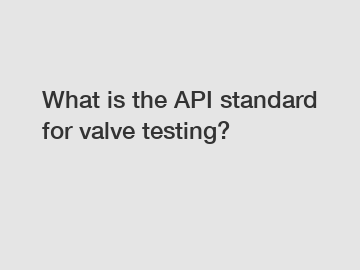What is the API standard for valve testing?
Valves are crucial components in various industries such as oil and gas, chemical, and manufacturing. They play a vital role in controlling the flow of fluids and gases to ensure the safety and efficiency of industrial processes. To ensure that valves perform as required, they need to undergo rigorous testing in accordance with recognized standards. One such standard is the American Petroleum Institute (API) standard for valve testing.
### What is the API Standard for Valve Testing?
The API standard for valve testing is outlined in API 598, entitled "Valve Inspection and Testing." This standard provides guidelines for the inspection and testing of industrial valves to ensure their proper functionality and reliability. The API 598 standard covers various types of valves, including gate, globe, check, ball, plug, and butterfly valves.

### Scope of API 598 Standard.
The API 598 standard specifies the requirements for valve inspection and testing, including visual inspection, pressure testing, and leakage testing. Visual inspection involves checking the valve for any visible defects, such as cracks, corrosion, or misalignment. Pressure testing is carried out to verify the valve's ability to withstand the specified pressure without leaking. Leakage testing is performed to ensure that the valve does not leak under pressure.
### Requirements for Valve Testing.
According to the API 598 standard, valves must undergo certain tests to validate their performance and integrity. These tests include seat leakage test, shell test, and backseat test. The seat leakage test is conducted to assess the tightness of the valve seat under pressure. The shell test is performed to check the strength of the valve body and closure member. The backseat test evaluates the sealing capability of the valve stem when the valve is fully open.
### Compliance with API Standard.
Valve manufacturers and users are encouraged to comply with the API 598 standard to ensure the quality and reliability of valves. By following the standard procedures for valve inspection and testing, companies can minimize the risk of valve failure and prevent costly downtime. Compliance with the API standard also helps in maintaining a consistent level of quality across different valve types and brands.
### Conclusion.
In conclusion, the API standard for valve testing, as outlined in API 598, provides essential guidelines for ensuring the performance and integrity of industrial valves. By following the standard procedures for valve inspection and testing, companies can ensure that valves meet the required quality and safety standards. Compliance with the API standard is essential for maintaining the reliability of valves in various industrial applications.
For more information on the API standard for valve testing or to inquire about valve testing services, please feel free to contact us.
If you are looking for more details, kindly visit peek o ring, peek valve seat material, peek seal material.
147
0
0

Comments
All Comments (0)